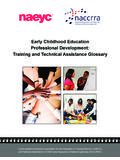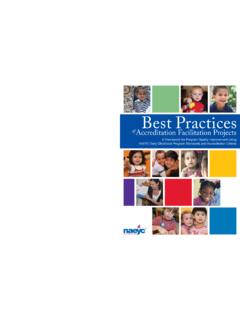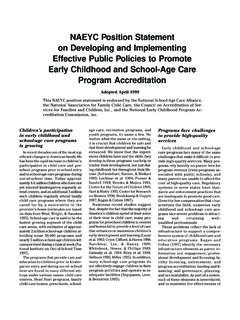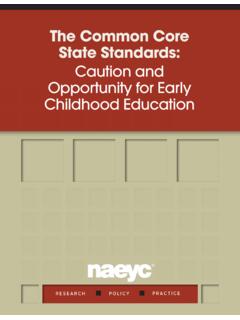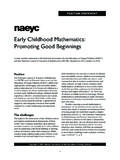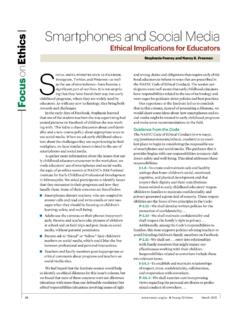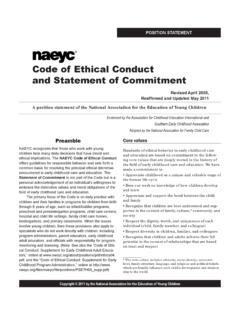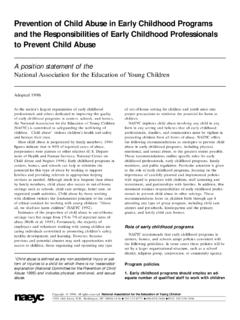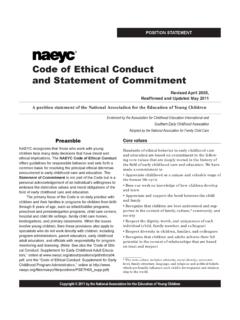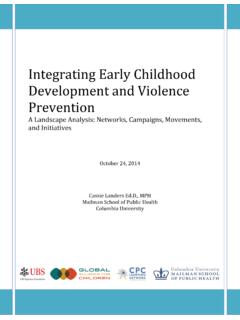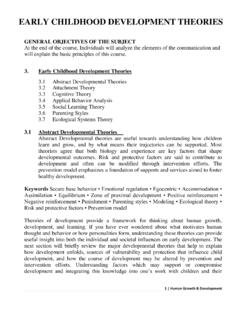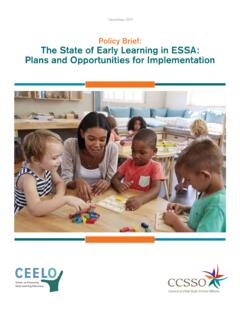Transcription of Technology and Interactive Media as Tools in Early ...
1 1media. When the inte-gration of Technology and Interactive Media in Early childhood programs is built upon solid develop-mental foundations, and Early childhood professionals are aware of both the challenges and the opportunities, educa-tors are positioned to improve program quality by intention-ally leveraging the potential of Technology and Media for the benefit of every and Interactive Media as Tools in Early childhood Programs Serving Children from Birth through Age 8A joint position statement of the National Association for the Education of Young Children and the Fred Rogers Center for Early Learning and Children s Media at Saint Vincent CollegeTelevision was once the newest Technology in our homes, and then came videos and computers.
2 Today s children are growing up in a rapidly changing digital age that is far different from that of their parents and grandpar-ents. A variety of technologies are all around us in our homes, offices, and schools. When used wisely, Technology and Media can support learning and relationships. Enjoyable and engaging shared expe-riences that optimize the potential for children s learning and development can support children s relationships both with adults and their peers. Thanks to a rich body of research, we know much about how young children grow, learn, play, and develop.
3 There has never been a more important time to apply principles of development and learning when con-sidering the use of cutting-edge technologies and new This statement is intended primarily to provide guidance to those working in Early childhood education programs serving children from birth through age 8. Although not developed as a guide for families in the selection and use of Technology and Interactive Media in their homes, the information here may be helpful to inform such and the Fred Rogers Center do not endorse or recom-mend software, hardware, curricula, or other STATEMENTADOPTED JANUARY 2012 Interactive Media refers to digital and analog materials, including soft-ware programs, applications (apps)
4 , broadcast and streaming Media , some children s television programming, e-books, the Internet, and other forms of content designed to facilitate active and creative use by young children and to encourage social engagement with other children and adults. 2 This 2012 position statement reflects the ever-changing digital age and provides guidance for Early childhood educators about the use of Technology and Interactive Media in ways that can optimize opportunities for young children s cognitive, social, emotional, physical, and linguistic development.
5 In this position statement, the definition of Technology Tools encompasses a broad range of digital devices such as computers, tablets, multitouch screens, Interactive whiteboards, mobile devices, cam-eras, DVD and music players, audio recorders, electronic toys, games, e-book readers, and older analog devices still being used such as tape recorders, VCRs, VHS tapes, record and cassette players, light tables, projectors, and microscopes. Throughout the process of researching and writing this position statement, we have been guided by the legacy of Fred Rogers.
6 By appropriately and intentionally using the Technology of his day broadcast television to connect with each individual child and with parents and families, Fred Rogers demonstrated the positive potential of using Technology and Media in ways that are grounded in prin-ciples of child of the Issues Technology and Interactive Media are here to stay. Young children live in a world of Interactive Media . They are growing up at ease with digital devices that are rapidly becoming the Tools of the culture at home, at school, at work, and in the community (Kerawalla & Crook 2002; Calvert et al.)
7 2005; National Institute for Literacy 2008; Buckleitner 2009; Lisenbee 2009; Berson & Berson 2010; Chiong & Shuler 2010; Couse & Chen 2010; Rideout, Lauricella, & Wartella 2011). Technology Tools for communication, collaboration, social network-ing, and user-generated content have transformed mainstream culture. In particular, these Tools have transformed how parents and families manage their daily lives and seek out entertainment, how teachers use materials in the classroom with young children and com-municate with parents and families, and how we deliver teacher education and professional development (Ride-out, Vandewater, & Wartella 2003; Roberts & Foehr 2004; Rideout & Hamel 2006; Rideout 2007; Foundation for Excellence in Education 2010; Gutnick et al.
8 2010; Barron et al. 2011; Jackson 2011a, 2011b; Wahi et al. 2011). The pace of change is so rapid that society is experiencing a disruption almost as significant as when there was a shift from oral language to print literacy, and again when the printing press expanded access to books and the printed word. The shift to new Media literacies and the need for digital literacy that encom-passes both Technology and Media literacy will continue to shape the world in which young children are developing and learning (Linebarger & Piotrowski 2009; Flewitt 2011; Alper ).
9 The prevalence of electronic Media in the lives of young children means that they are spending an increasing number of hours per week in front of and engaged with screens of all kinds, including televisions, computers, smartphones, tablets, handheld game devices, and game consoles (Common Sense Media 2011). The distinction among the devices, the content, and the user experience has been blurred by multitouch screens and movement-activated technologies that detect and respond to the child s movements. With guidance, these vari-ous Technology Tools can be harnessed for learning and devel-opment; without guidance, usage can be inappropriate and/or interfere with learning and development.
10 There are concerns about whether young children should have access to Technology and screen Media in Early childhood programs. Several professional and public health organiza-tions and child advocacy groups concerned with child development and health issues such as obesity have recom-mended that passive, non- Interactive Technology and screen Media not be used in Early childhood pro-grams and that there be no screen time for infants and toddlers. NAEYC and the Fred Rogers Center are also concerned about child development and child health issues and have considered them carefully when developing this position Media include certain television programs, videos, DVDs, and streaming Media now available on a vari-ety of screens.
